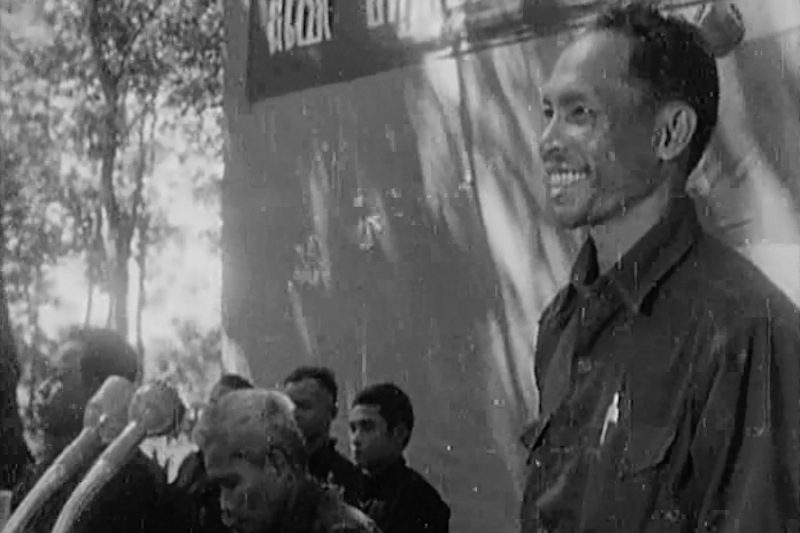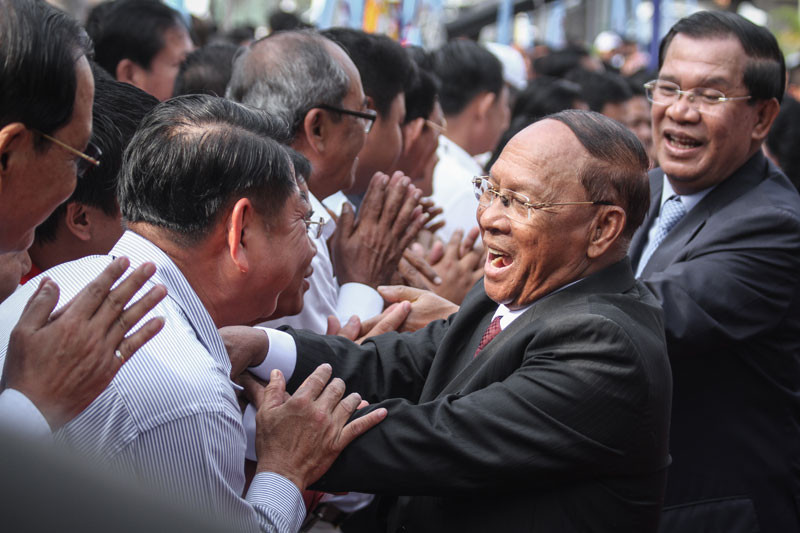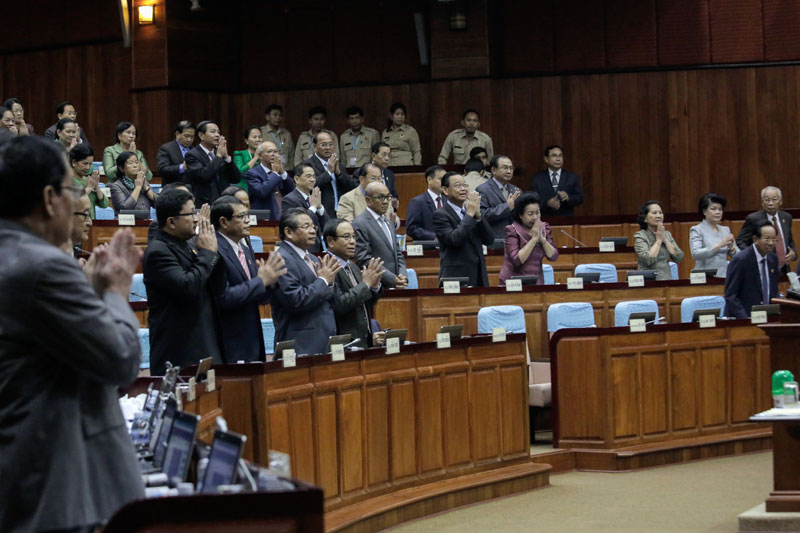At the Khmer Rouge tribunal in June, defense attorneys played grainy, black-and-white footage of Pol Pot walking through a rally in the regime’s East Zone alongside its commander, Sao Phim, in 1978. The silent film cuts to a man with a beaming smile raising his fist in the air and shouting to hundreds of young cadre, who respond with three synchronized fist punches.
—News Analysis—
That smiling man is National Assembly President Heng Samrin, declared Victor Koppe, a lawyer for the regime’s second-in-command Nuon Chea. Mr. Koppe was immediately reprimanded by Trial Chamber President Nil Nonn, who branded the claim “far-fetched.”

The man—who bears a striking resemblance to Mr. Samrin—may or may not be the CPP stalwart who today appears alongside Prime Minister Hun Sen on ruling party propaganda.
The tribunal may never know.
Dozen of requests have been made for Mr. Samrin to appear in Case 002—in which the regime’s Brother Number Two and former head of state, Khieu Samphan, have been on trial since 2011. The first trial in the case focused mainly on urban evacuations overseen by the Khmer Rouge, while the ongoing second trial includes a range of charges including genocide.
The first request came in September 2009, when Co-Investigating Judge Marcel Lemonde sought the testimonies of Mr. Samrin, late CPP President Chea Sim, then-Foreign Affairs Minister Hor Namhong, then-Finance Minister Keat Chhon, and CPP senators Ouk Bunchhoeun and Sim Ka.
All the requests were ignored, fueling claims of political interference at the hybrid U.N.-Cambodian court. In 2014, the Trial Chamber failed to reach a consensus on whether to summon Mr. Samrin. Cambodian judges blocked the request, labeling Mr. Samrin’s potential testimony of “lesser relevance” despite the international judge’s assertion that he could have offered vital testimony.
Mr. Samrin, the international judges wrote at the time, “appears to have played a significant role within the armed units who conducted the evacuation of Phnom Penh and is likely to be able to offer unique and relevant testimony regarding the [Democratic Kampuchea]-era policies, the course of the forced evacuation of Phnom Penh and command structures.”
Secret Courier
Born into a peasant family in Kompong Cham province in 1934, Mr. Samrin joined the underground communist movement in 1961, writes historian Ben Kiernan in his book, “The Pol Pot Regime.”
Initially working as a secret courier in the East Zone under the leadership of Sao Phim, Mr. Samrin would deliver messages to fellow communists in Phnom Penh, including Pol Pot, and eventually became a commander who played a “prominent role” in the capture of Phnom Penh, Mr. Kiernan writes.
Details about his responsibilities after the Khmer Rouge took full control of the country remain unclear, although Mr. Samrin told Mr. Kiernan in an interview that he became commander of the East Zone’s Fourth Infantry Division in 1976 and served as deputy chief of the zone’s military staff.
Mr. Samrin told the historian that the East Zone was “looser” in its structure than other regions during the Khmer Rouge and that he secretly opposed the Pol Pot-led center of the Communist Party of Kampuchea.

“We had the principle to speak up, but did not dare to. We thought so after liberation in 1975, [when] we knew clearly that the [ruling] principles were not good,” he is quoted as saying in Mr. Kiernan’s book, “Genocide and Resistance in Southeast Asia.”
“In 1976-77, we had a struggle, but a secret one,” he said. “Things were tight and cramped. There was no opportunity to rise up and struggle. Even Ta [Sao] Phim was concerned about testing the conditions for a struggle.”
Eventually, as purges in the East Zone intensified amid fears among the Khmer Rouge leadership of a Vietnamese-backed rebellion, Mr. Samrin fled to Vietnam and helped form the United Front for the National Salvation of Kampuchea. Soon after the Vietnamese-backed overthrow of the Khmer Rouge in January 1979, he was installed as the de facto leader of the People’s Republic of Kampuchea.
‘Unparalleled’ Insight
Mr. Samrin’s knowledge of the inner workings of the Khmer Rouge has become more pertinent in recent months as the court has been hearing testimony relating to internal purges, much of which occurred in the East Zone. A document filed by the Nuon Chea defense on August 1 stated that Pol Pot’s second-in-command would only break his silence—he last addressed the court in April—if Mr. Samrin testified.
Doreen Chen, senior legal consultant for the Nuon Chea defense team, said Mr. Samrin could offer “unparalleled” insight into what really happened in the East.
“Heng Samrin is the single most important witness in Case 002 overall and is in a completely different stratosphere to every other witness in the case,” she said.
A cornerstone of the Nuon Chea defense is that there was a Vietnamese-backed internal rebellion waged by Sao Phim in the East Zone, which they say prevented the communist revolution from being carried out as planned, and shows that regime leaders did not have strict control over decisions being made below them.
“Heng Samrin defected from the CPK, was allegedly Sao Phim’s right-hand man, and became the leader of the liberation army and thereafter the leader of the puppet government. Therefore, he is able to provide critical evidence for the heart of our case—that there was an internal rebellion within the CPK led by defecting CPK leaders and supported by Vietnam,” Ms. Chen said.
“In his leading role, he can tell us not only about how the rebellion was planned and executed and by whom, but also about the specifics of Vietnam’s foreign policy aims vis-a-vis Cambodia and how they fulfilled those aims by sponsoring an internal rebellion and eventually invading Cambodia,” she said.
Her conclusion is disputed by Craig Etcheson, a prominent researcher who served as chief of investigations in the tribunal’s Office of the Co-Prosecutors. He agreed that Mr. Samrin could provide valuable evidence, but in proving Nuon Chea’s culpability in crimes committed in the East Zone.
“Heng Samrin would have been a very important witness. He was privy to most of the inner workings of the East Zone, and some of the inner workings of the [Party] Center,” Mr. Etcheson said in an email.
“He could have provided direct testimony of Nuon Chea’s intimate role in a number of the regime’s policies, which are at the heart of the charges against him, including purges generally, the East Zone Massacre, the elimination of Buddhism, and the repression of the Khmer Republic personnel, among others,” he said.

“He would also be able to drive a stake through the heart of the Nuon team’s principal argument, to wit, that Pol Pot was simply putting down rebellions inspired by Vietnam.”
Whether Mr. Samrin could offer evidence to support or refute the Nuon Chea defense can only be tested by an appearance in court, said Heather Ryan, a tribunal monitor for the Open Society Justice Initiative.
“The Nuon Chea defense team have made an extended, passionate and persuasive argument that Heng Samrin is a relevant, if not essential, witness to their theory of the defense,” Ms. Ryan said. “Whether this is in fact true and not just defense hyperbole can only be tested by actually hearing what he has to say.”
“Given the importance, scope and length of the Case 002 trials, it is hard to understand why the single most requested witness, one that is said to have unique and relevant information, cannot be called,” she said. “The failure to do so leaves questions about whether the full and complex story of the inner workings of the Khmer Rouge is being adequately addressed.”
Looming Shadow
National Assembly spokesman Leng Peng Long confirmed the tribunal had delivered a summons in 2009, but said that Mr. Samrin refused to accept it. He said he had no idea why Mr. Samrin rejected the summons and referred questions to the Assembly president’s personal cabinet. Keo Piseth, Mr. Samrin’s cabinet chief, declined to comment, as did CPP spokesman Suos Yara.
David Chandler, a prominent historian on Cambodia, said the looming shadow of Mr. Hun Sen and his ruling party over the court meant no top government official would ever appear on the stand.
“I don’t think any high ranking Cambodian officials were ever going to testify,” he said in an email. The CPP sees the tribunal—officially called the Extraordinary Chambers in the Courts of Cambodia (ECCC)—as a “foreign invention and a semi-colonial intrusion,” he added.
“In an ideal world, Heng Samrin would be interesting as a senior Eastern Zone commander in the years 1977-8, but he will never testify,” he said. “Hun Sen set the parameters for the ECCC long ago (whatever the U.N. thinks), and he runs the country.”
(Additional reporting by Ben Sokhean)




